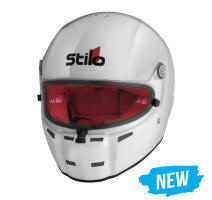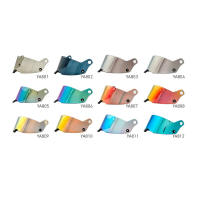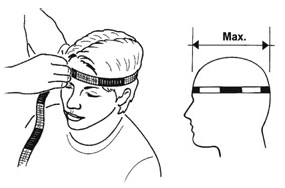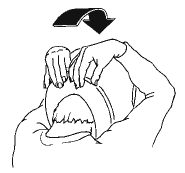

Monza Circuit - since 1974
Series KART - ADULTI
K 2020


Optimal fit is essential for all helmets and even more so for Competition helmets. Competition Market is an expert dealer who can help you determine the right helmet for you, for safety, fit and comfort. Tips for determining optimal fit:
1.MEASUREMENT.
 Measuring the head is a starting point for the entire sizing procedure. Due to varying shapes, heads that are apparently the same size when measured by a tape may not necessarily fit the same size helmet. The circumference of the head should be measured at a point approximately two centimeters above the eyebrows in front and at a point in the back of the head that results in the largest possible measurement. Take several measurements to make sure you have the largest one.
Measuring the head is a starting point for the entire sizing procedure. Due to varying shapes, heads that are apparently the same size when measured by a tape may not necessarily fit the same size helmet. The circumference of the head should be measured at a point approximately two centimeters above the eyebrows in front and at a point in the back of the head that results in the largest possible measurement. Take several measurements to make sure you have the largest one.
2.TRY ON.
Once you have determined your preliminary tape measurement, select the helmet that is closest in hat size to the tape measurement and try on the helmet. If it is between sizes, round up to the next largest one. The correct procedure to put on the helmet is:
If the helmet slides down on the head with no resistance, you have your first indication that it may be too large. Obviously, if it will not slide down over the head at all it is too small. Many people unfamiliar with helmets are reluctant to pull down if they meet resistance as the helmet goes on, however if it is just snug going on, we recommend to get the helmet on. Only if the helmet is impossible to put on should you move up to the next size, as helmets that go on snug generally fit very well once all the way on. It is a fact that most people will select a helmet that is too large for them, if left to make their own choice. The eyes should be approximately in the center of the eye port with the top edge of the liner padding just above the eyebrows.
3.HORIZONTAL AND VERTICAL MOVEMENT CHECK
 Once you are
Once you are
wearing the helmet, you should look carefully at the way it fits. Check to see
if the cheek pads are in contact with the cheeks. Is there excess pressure on
the cheeks? Look for gaps between the temples and the brow pad. Check the back
of the helmet where the neck roll (if the helmet has one) makes contact with the
neck. Does it touch at all? Or is it pushing the helmet away at the rear causing
it to roll down over the eyes in front. After you have made your visual check,
grab the helmet in your hands - one on either side - and while holding your head
steady try to rotate the helmet from side to side. Note any movement of the skin
while doing this, as well as the amount of resistance to movement. Next, check
movement up and down, again noting skin movement and resistance. If in either
test there was little or no skin movement, and/or the helmet moved very easily,
the helmet is too large. A properly fitted helmet will cause the skin to move as
the helmet moves. And, it will feel to the wearer as if evenly distributed
pressure is being continuously exerted around the head.
4.RETENTION CHECK
 This test may be a little uncomfortable, but it is very important to check. Fasten the chin strap tightly fastened, hold your head steady, and grab the rear bottom edge with your fingers. Then try to roll the helmet off your head. If it comes off, it is undoubtedly too large. WARNING: Do not buy a helmet that can be rolled off the head with the strap fastened.
This test may be a little uncomfortable, but it is very important to check. Fasten the chin strap tightly fastened, hold your head steady, and grab the rear bottom edge with your fingers. Then try to roll the helmet off your head. If it comes off, it is undoubtedly too large. WARNING: Do not buy a helmet that can be rolled off the head with the strap fastened.
5.PRESSURE POINT CHECK
Finally, unfasten the chin strap and remove the helmet. Immediately after the helmet has been removed, observe coloration of the skin of the forehead and cheeks. A reddening of the skin in a small area may indicate a pressure point. Pressure points sometimes are not noticed by the wearer for several minutes, or even hours later. They sometimes cause headaches, and are at the least, uncomfortable. If you notice a pressure point, but cannot remember experiencing discomfort there while wearing the helmet, put the helmet back on for a few minutes, paying particular attention to the anticipated pressure point. If you experience complains of pressure point discomfort either time, go to the next larger size, repeating steps four and five.
Kart
€ 567,00 + tax
Series KART - KIDS
CMR 2016


Optimal fit is essential for all helmets and even more so for Competition helmets. Competition Market is an expert dealer who can help you determine the right helmet for you, for safety, fit and comfort. Tips for determining optimal fit:
1.MEASUREMENT.
 Measuring the head is a starting point for the entire sizing procedure. Due to varying shapes, heads that are apparently the same size when measured by a tape may not necessarily fit the same size helmet. The circumference of the head should be measured at a point approximately two centimeters above the eyebrows in front and at a point in the back of the head that results in the largest possible measurement. Take several measurements to make sure you have the largest one.
Measuring the head is a starting point for the entire sizing procedure. Due to varying shapes, heads that are apparently the same size when measured by a tape may not necessarily fit the same size helmet. The circumference of the head should be measured at a point approximately two centimeters above the eyebrows in front and at a point in the back of the head that results in the largest possible measurement. Take several measurements to make sure you have the largest one.
2.TRY ON.
Once you have determined your preliminary tape measurement, select the helmet that is closest in hat size to the tape measurement and try on the helmet. If it is between sizes, round up to the next largest one. The correct procedure to put on the helmet is:
If the helmet slides down on the head with no resistance, you have your first indication that it may be too large. Obviously, if it will not slide down over the head at all it is too small. Many people unfamiliar with helmets are reluctant to pull down if they meet resistance as the helmet goes on, however if it is just snug going on, we recommend to get the helmet on. Only if the helmet is impossible to put on should you move up to the next size, as helmets that go on snug generally fit very well once all the way on. It is a fact that most people will select a helmet that is too large for them, if left to make their own choice. The eyes should be approximately in the center of the eye port with the top edge of the liner padding just above the eyebrows.
3.HORIZONTAL AND VERTICAL MOVEMENT CHECK
 Once you are
Once you are
wearing the helmet, you should look carefully at the way it fits. Check to see
if the cheek pads are in contact with the cheeks. Is there excess pressure on
the cheeks? Look for gaps between the temples and the brow pad. Check the back
of the helmet where the neck roll (if the helmet has one) makes contact with the
neck. Does it touch at all? Or is it pushing the helmet away at the rear causing
it to roll down over the eyes in front. After you have made your visual check,
grab the helmet in your hands - one on either side - and while holding your head
steady try to rotate the helmet from side to side. Note any movement of the skin
while doing this, as well as the amount of resistance to movement. Next, check
movement up and down, again noting skin movement and resistance. If in either
test there was little or no skin movement, and/or the helmet moved very easily,
the helmet is too large. A properly fitted helmet will cause the skin to move as
the helmet moves. And, it will feel to the wearer as if evenly distributed
pressure is being continuously exerted around the head.
4.RETENTION CHECK
 This test may be a little uncomfortable, but it is very important to check. Fasten the chin strap tightly fastened, hold your head steady, and grab the rear bottom edge with your fingers. Then try to roll the helmet off your head. If it comes off, it is undoubtedly too large. WARNING: Do not buy a helmet that can be rolled off the head with the strap fastened.
This test may be a little uncomfortable, but it is very important to check. Fasten the chin strap tightly fastened, hold your head steady, and grab the rear bottom edge with your fingers. Then try to roll the helmet off your head. If it comes off, it is undoubtedly too large. WARNING: Do not buy a helmet that can be rolled off the head with the strap fastened.
5.PRESSURE POINT CHECK
Finally, unfasten the chin strap and remove the helmet. Immediately after the helmet has been removed, observe coloration of the skin of the forehead and cheeks. A reddening of the skin in a small area may indicate a pressure point. Pressure points sometimes are not noticed by the wearer for several minutes, or even hours later. They sometimes cause headaches, and are at the least, uncomfortable. If you notice a pressure point, but cannot remember experiencing discomfort there while wearing the helmet, put the helmet back on for a few minutes, paying particular attention to the anticipated pressure point. If you experience complains of pressure point discomfort either time, go to the next larger size, repeating steps four and five.
Kart
from € 490,00 + tax
Series KART - KIDS
CMR 2016

Optimal fit is essential for all helmets and even more so for Competition helmets. Competition Market is an expert dealer who can help you determine the right helmet for you, for safety, fit and comfort. Tips for determining optimal fit:
1.MEASUREMENT.
 Measuring the head is a starting point for the entire sizing procedure. Due to varying shapes, heads that are apparently the same size when measured by a tape may not necessarily fit the same size helmet. The circumference of the head should be measured at a point approximately two centimeters above the eyebrows in front and at a point in the back of the head that results in the largest possible measurement. Take several measurements to make sure you have the largest one.
Measuring the head is a starting point for the entire sizing procedure. Due to varying shapes, heads that are apparently the same size when measured by a tape may not necessarily fit the same size helmet. The circumference of the head should be measured at a point approximately two centimeters above the eyebrows in front and at a point in the back of the head that results in the largest possible measurement. Take several measurements to make sure you have the largest one.
2.TRY ON.
Once you have determined your preliminary tape measurement, select the helmet that is closest in hat size to the tape measurement and try on the helmet. If it is between sizes, round up to the next largest one. The correct procedure to put on the helmet is:
If the helmet slides down on the head with no resistance, you have your first indication that it may be too large. Obviously, if it will not slide down over the head at all it is too small. Many people unfamiliar with helmets are reluctant to pull down if they meet resistance as the helmet goes on, however if it is just snug going on, we recommend to get the helmet on. Only if the helmet is impossible to put on should you move up to the next size, as helmets that go on snug generally fit very well once all the way on. It is a fact that most people will select a helmet that is too large for them, if left to make their own choice. The eyes should be approximately in the center of the eye port with the top edge of the liner padding just above the eyebrows.
3.HORIZONTAL AND VERTICAL MOVEMENT CHECK
 Once you are
Once you are
wearing the helmet, you should look carefully at the way it fits. Check to see
if the cheek pads are in contact with the cheeks. Is there excess pressure on
the cheeks? Look for gaps between the temples and the brow pad. Check the back
of the helmet where the neck roll (if the helmet has one) makes contact with the
neck. Does it touch at all? Or is it pushing the helmet away at the rear causing
it to roll down over the eyes in front. After you have made your visual check,
grab the helmet in your hands - one on either side - and while holding your head
steady try to rotate the helmet from side to side. Note any movement of the skin
while doing this, as well as the amount of resistance to movement. Next, check
movement up and down, again noting skin movement and resistance. If in either
test there was little or no skin movement, and/or the helmet moved very easily,
the helmet is too large. A properly fitted helmet will cause the skin to move as
the helmet moves. And, it will feel to the wearer as if evenly distributed
pressure is being continuously exerted around the head.
4.RETENTION CHECK
 This test may be a little uncomfortable, but it is very important to check. Fasten the chin strap tightly fastened, hold your head steady, and grab the rear bottom edge with your fingers. Then try to roll the helmet off your head. If it comes off, it is undoubtedly too large. WARNING: Do not buy a helmet that can be rolled off the head with the strap fastened.
This test may be a little uncomfortable, but it is very important to check. Fasten the chin strap tightly fastened, hold your head steady, and grab the rear bottom edge with your fingers. Then try to roll the helmet off your head. If it comes off, it is undoubtedly too large. WARNING: Do not buy a helmet that can be rolled off the head with the strap fastened.
5.PRESSURE POINT CHECK
Finally, unfasten the chin strap and remove the helmet. Immediately after the helmet has been removed, observe coloration of the skin of the forehead and cheeks. A reddening of the skin in a small area may indicate a pressure point. Pressure points sometimes are not noticed by the wearer for several minutes, or even hours later. They sometimes cause headaches, and are at the least, uncomfortable. If you notice a pressure point, but cannot remember experiencing discomfort there while wearing the helmet, put the helmet back on for a few minutes, paying particular attention to the anticipated pressure point. If you experience complains of pressure point discomfort either time, go to the next larger size, repeating steps four and five.
Kart
from € 490,00 + tax